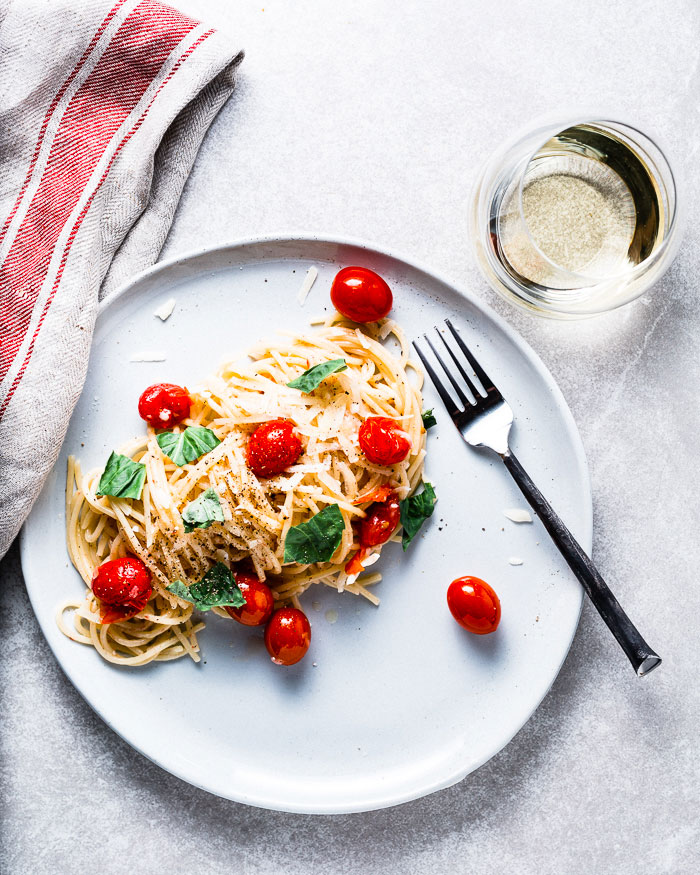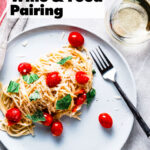Foodies know the feeling of tasting that perfect dish where all of the elements just come together in harmony. One bite and you’re in a dream-like state, chewing much slower than you normally do. Wine enthusiasts experience the same bliss when they taste a perfectly balanced, well-crafted glass of wine. Pairing food and wine is all about combining those two loves, creating a sensory happy place.
Choosing the best bottle to enjoy with your meal is a matter of knowing wine basics and the main elements of your food. The idea is to avoid conflicting pairings, which can make everything taste “off.” Think of how red wine or orange juice tastes after you brush your teeth. Some foods just taste funky with certain wines.
There are no exact rules written in stone. So, the first thing to remember is no meal will be absolutely ruined if the perfect wine isn’t served with whatever you’re eating. Eat and drink what you like. But, keep an open mind when exploring different styles of wine and recipes.
Look for Complementary Elements
The classic school of thought is fish goes with white wine and red meat goes with red wine. It’s a safe bet, but not a steadfast rule. Pairing like with like, such as lighter dishes with lighter wine, is generally a good idea. However, there are always exceptions.
- Acidity in wine makes our mouths water, giving wine its lively, bright notes. Like with like, or congruent pairings, complement each other. For example, Italian spaghetti with tomato sauce pairs great with Italian Chianti, which tends to have higher acid and lower tannins.
- Tannins are primarily detected in red wine. They give an astringent, sometimes bitter texture on your tongue. Tannins can make fish taste “fishy” while enhancing bitterness and heat. Also, fat helps balance bitter flavors. Foods like cheese, as well as fat in meat work well with red wines high in tannins like Cabernet Sauvignon and Nebbiolo.
- Sweetness in wine helps balance spicy food. This is why an off-dry rosé pairs great with Thai food. If your dish has a lot of sweetness, a dry wine will taste sour. You just don’t want your wine sweeter than the food, this is why super sweet wines like Golden Bordeaux pair great with savory, like gorgonzola or blue cheese.
- Alcohol in wine, especially dry styles (low in sugar) with higher ABV, can add to heat and spice. Pairing your favorite red wine with a spicy hot meal will make everything taste too hot. Also, your wine will taste flabby and dull. Lower alcohol wines, and those with a bit of sweetness, work better with spicy dishes. Great options are an off-dry Riesling, sparkling or rosé. But, what about red wines known for having higher alcohol? Zinfandel, a full-bodied red wine that can be higher in alcohol, works with tangy, spicy, sweet BBQ because they have ripe fruits, lower tannins and complementary flavors.
- Salty foods and sauces generally pair with most wines. Salt can soften tart acidity in lemon and vinegar, but you want to try to avoid more salt than acid. New Zealand Sauvignon Blanc, known for having high acidity, works well with salt, giving it a smoother mouthfeel. Contrasting flavors like sweet and salty are another match made in palate heaven (chocolate and sea salt, anyone?). Sweetness in the wine can mute the saltiness in food, so next time you accidentally add too much salt to a dish, try pairing it with a semi-sweet wine like Riesling or rosé and see if it helps!
Light with Light
Lighter meats pair well with lighter wines. Recipes like sous vide chicken breasts with simple green herbs love dry, white wines like Riesling and Sauvignon Blanc. Red varietals like Cabernet or Mourvèdre would overpower the meal, making the chicken taste bland. As a result, bitter notes in the greens would emphasize bitter tannins in the wine. So, if your heart is set on that great bottle of Napa Cab, just eat the meal and drink the wine after with a bit of aged cheddar.
Try pairing fish tacos with Vinho Verde from Portugal or Sauvignon Blanc from New Zealand. The fresh, green and citrus notes in the wine work in harmony with lighter, white fish and squeeze of fresh lime.
Examples of white wines with lighter body and higher acidity that pair well with lighter dishes like chicken, turkey, salads and citrus flavors are: Sauvignon Blanc, Riesling, Pinot Grigio, Albariño and Vinho Verde. The delicate flavors and textures get along well with the lighter wines, as they don’t overpower one another.
Heavy with Heavy
Heavier meats pair better with fuller-bodied wines. Meaty, juicy steak loves fuller-bodied, higher tannin Cabernet Sauvignon. The fat in the steak just works to soften the effect of strong tannin. But, if you’re grilling a leaner meat like flank steak with lighter seasoning, try pairing with Merlot, which tends to be softer (less astringent tannins) than Cabernet.
Pairing to avoid: Red wines with high tannin like Cabernet Sauvignon can make fish taste “fishy” and your wine will taste more metallic. Best to stick with white wines like Chardonnay, Riesling, Sauvignon Blanc or sparkling wine. Lighter, low-tannin reds like Pinot Noir or Gamay are also better options.
Chicken can pair with reds, depending on the sauce!
Consider the Sauce
If you choose a richer, creamy sauce with the same sous vide chicken breasts, a lighter, citrusy Sauvignon Blanc may not work the best. Oaked Chardonnay, which often has a fuller body and buttery notes, would make a better congruent pairing. Or, even a Brut sparkling wine would match the heavier sauce better, giving a palate-cleansing effect.
Congruent pairings, or pairing like with like, work to match similar elements in food (ex: creamy sauce with oaked Chardonnay).
Since spicy likes sweet, an off-dry white, sparkling or rosé works best with bold flavors like curry and teriyaki. Barbeque begs for similar flavors in wine. California Zinfandel or Petite Sirah is great for grilled foods, as the smoky, savory, peppery flavors match well with similar characteristics of the wine. So, just because it’s lighter white meat (same goes for turkey and pork) doesn’t mean we always go with a light, white wine. Always consider the sauce. Is it salty, tangy, spicy or buttery? Seasoning often determines what wine would work best.
Tip: Don’t pair spicy foods with high-alcohol, high-tannin red wines.
Other Flavors
Fatty fish like salmon loves white wines like unoaked Chardonnay and dry rosé. They’re a bit fuller bodied than lighter whites, while also having enough acidity to cut through the fat. But, what if you’re making a mushroom sauce? Mushroom sauces works best with lighter reds like Pinot Noir or Gamay. Both are lighter in body, alcohol and tannins, and have congruent earthy notes.
Pinot Noir is known for being a universally food-friendly wine and works especially well with mushroom dishes.
Smoked foods pair best with similar intensity wines. For instance, a rich, heavier smoked beef brisket would match best with a fuller-bodied red, such as Bordeaux, Petite Sirah or Cabernet. Lighter smoky dishes like shredded pork shoulder pair great with medium-bodied reds like Pinot Noir, Rioja or Grenache. A quality rosé is always a great option too, as it has the quality of a chilled white wine with a red wine’s fuller body and characteristics.
“A gourmet meal without a glass of wine just seems tragic to me somehow.”
— Kathy Mattea
3 Universally Food-Friendly Wines (Cheat Sheet)
Sparkling Wine
Sparkling wine pairs with everything from smoked salmon to popcorn. For fancier hors d’oeuvres or expensive caviar, pair with Champagne. Casual meals like deep-fried foods, Asian take-out or even a bag of potato chips pair better with budget-friendly sparkling wine. For example, a less sweet, Brut style or pét-nat (natural sparkling wine) would work great. Sparkling rosé, especially from quality producers, can hold up well to sausage dishes too.
Try buttery popcorn with Chardonnay or Blanc de Blancs sparkling wine.
Riesling
Riesling has great acidity and is similar to dry sparkling wine in that it has this palate-cleansing effect. So, it just works with everything from lemony to savory to creamy dishes. It’s one of the most food-friendly white wines out there. Off-dry or slightly sweet styles are better for spicier foods. It’s also a safe bet with vegetable dishes.
Try Riesling with Sausage, Peppers and Broccolini Pasta.
Pinot Noir
Pinot Noir is perhaps the most food-friendly, versatile red wine. It doesn’t overpower dishes, has lower tannins and body, and is universally palate friendly. Known for pairing with a variety of dishes, from duck to charcuterie to pasta, it’s just always a good choice. Also, if you have any type of mushroom dish, this is the wine you want to choose.
Try Pinot Noir with Pork Schnitzel and Mushroom Sauce.
Tip: Invited to a potluck where a hodgepodge of foods will served? Go with Pinot Noir, a dry sparkling rosé or Gamay. Rosé can be elegant, giving the light brightness of a white wine with body and complexity of a red. They’re the safest bets, most palate-friendly and universally likable. Even if it’s a cheese party, a tannin-rich Nebbiolo or Cabernet can overpower most foods and leave everyone with heavy palates.
Remember to serve light red wines slightly chilled!
Food and Wine Pairings Should Be Fun
When it comes to pairing food and wine, you’ll come across many different opinions and recommendations. Ideally, we drink and eat what we’re in the mood for and not worry too much about perfect pairings. Light with light, savory with savory, sweet with salty — experimenting with different wines, new dishes and flavor combinations is the best way to have fun with it and see (or taste) for yourself.
By Misty Clark
Misty Clark writes about wine and the unique stories behind each label. She is a former R.D.H. (Registered Dental Hygienist) with an applied science degree and has been geeking out about wine for over 20 years. Before obtaining a Wine & Spirit Education Trust certification, she learned about wine just by trying different styles and regions. She is also the author of the Red Wine Cats blog, where she takes a casual approach to learning about wine as well as working with a local distributor in wine sales. “Wine (and food) brings people together, and we’ll never run out of new things to learn!”
Misty’s Blog
Follow Misty on Twitter
Follow Misty on Instagram


